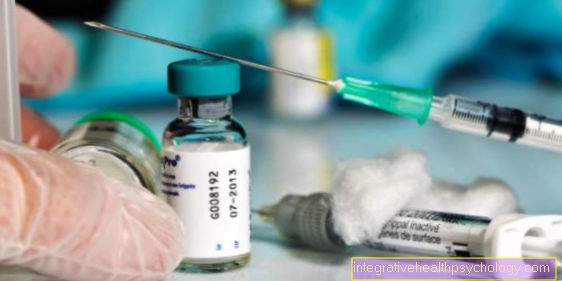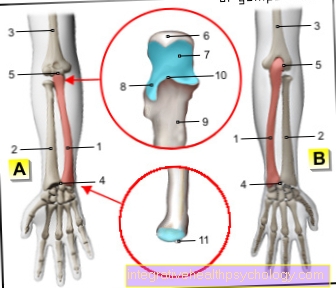Gastric balloon for weight loss
Synonyms in the broader sense
Stomach reduction, gastroplastics, sleeve stomach, Roux En Y bypass, small intestine bypass, biliopancreatic version according to SCOPINARO, billiopancreatic diversion with duodenal switch, gastric balloon, gastric pacemaker
Definition - What is a gastric balloon?
The gastric balloon can be thought of as a small balloon that is inserted into the stomach and thus reduces the filling capacity of the stomach. As a result, a feeling of satiety is felt more quickly, so that under optimal circumstances - i.e. with a healthy diet and exercise - weight reduction occurs more quickly. The gastric balloon is therefore a supportive measure for losing weight.

How does the insertion of a gastric balloon work?
A gastric balloon is implanted under a twilight anesthetic. First, the doctor does a gastroscopy. This means that he pushes a tube with a camera at the flexible end over his mouth and into his stomach. So the stomach can be assessed from the inside. If no obstacles or other abnormalities are found, the still empty balloon can then be inserted through the mouth via the esophagus into the stomach. The balloon is made of soft silicone and is filled with saline solution via a tube. This reduces the filling capacity of the stomach and at the same time activates the mechanoreceptors in the stomach wall. These register a filling of the stomach and give the brain a quick feeling of satiety. The gastric balloon is then separated from the tube, the balloon being equipped with a self-closing flap which closes it immediately after separation from the tube. The implant now floats freely in the stomach.
The procedure takes about 20 to 30 minutes. If the procedure goes without complications, the patient can be discharged after a few hours.
In the first few days after the operation, around 80% of patients experience nausea and around 40% have mild to moderate cramping abdominal pain. These symptoms usually go away after 2-7 days, during which the stomach gets used to the foreign body, and can also be relieved with medication if necessary. If the symptoms do not subside within this time, you must consider reducing the size or even removing the gastric balloon.
The balloon can remain in the stomach for a maximum of six months, as the material is attacked by the stomach acid over time and this can burst at some point. A gastroscopy as previously described is required for the removal. The doctor then sticks into the balloon with a hollow needle and can thus draw off the liquid and then pull out the empty balloon envelope.
Do I need anesthesia to insert the gastric balloon?
Before inserting a gastric balloon, a gastroscopy must be performed beforehand so that the doctor can see whether the procedure can be carried out at all. So-called sedation (twilight anesthesia) is therefore also necessary. It is not a general anesthetic but a kind of deep sleep. You still breathe yourself but you don't notice anything.
More information on this topic can be found at: Anesthesia - procedure and risks
Is the operation painful?
Inserting a gastric balloon is not an operation in the actual sense, but a so-called medical intervention. The procedure itself is usually not painful and you don't notice anything through the twilight anesthesia. However, upper abdominal pain often occurs in the first few days after the procedure. These are triggered by the foreign body in the stomach and usually subside again soon. If the pain persists or if new pain occurs over time, the treating doctor should be consulted at an early stage.
How long does the procedure last?
The actual procedure for inserting a gastric balloon only takes about 20 to 30 minutes. However, there is also the preparation time, for example for registering and laying a vein access. In addition, after the procedure you usually have to spend several hours in the recovery room until the effect of the twilight anesthesia wears off. This time can vary from person to person, as the anesthetics can have different effects on each patient. It is recommended that you avoid strenuous activity for the next few days until your body has fully recovered from the procedure.
Is it possible to insert the gastric balloon on an outpatient basis?
In most cases, the insertion of a gastric balloon is an outpatient procedure and you do not have to be admitted to the hospital. As soon as the effect of the twilight anesthesia wears off and the doctor gives the OK, you can go home again. However, you are not roadworthy for 24 hours and should therefore be picked up. Inpatient admission is only indicated if there is a complication during or after the procedure. In some cases, a temporary supply of fluids and salts via the vein is also necessary, which also requires hospitalization.
Which successes are realistic - How much can you lose weight with the help of the gastric balloon?
How much you can lose by inserting a gastric balloon and which successes are realistic depends primarily on the patient's motivation and discipline. The gastric balloon can only help you lose weight. Most importantly, the patient should change their diet and reduce their caloric intake. Increasing physical activity also plays an important role. Those who only use the gastric balloon without changing their lifestyle cannot expect great success. After removing the gastric balloon, a so-called yo-yo effect quickly occurs and the weight increases again, sometimes even higher than the initial weight. However, if you use the gastric balloon to help you change your lifestyle, you can lose ten to 30 kilograms, depending on your original weight. However, losing weight too quickly can also be dangerous. It is best to discuss with the attending physician individually before the procedure which weight loss is realistic and appropriate.
You might also be interested in: Lose weight by changing your diet
How is the gastric balloon removed?
The distance of the gastric balloon takes place in the same way as the implantation via the esophagus. The procedure takes time about 20 minutes and is also done under local anesthesia. First the Liquid aspirated and then removed the balloon. Then the patient can go straight home.
These are the risks of a gastric balloon
In addition to the anesthetic risks inherent in every surgical procedure, the assembly of a gastric balloon can lead to endoscopic complications. These include bleeding, perforations (organ breakthrough), cardiovascular disorders or the suction of stomach contents into the respiratory tract (especially the trachea).
The positioning of the gastric balloon is very important and if it is not done correctly, injury or perforation of the stomach or esophagus can also occur when the balloon is inflated.
If postoperative nausea persists for a long time, frequent vomiting can lead to metabolic disorders. These include severe water loss, alkalosis ("underacidification" of the body due to the loss of stomach acid), potassium deficiency up to functional kidney malfunction. If there is significant weight loss in a short period of time, symptoms such as a general feeling of weakness, tiredness or paleness may occur.
Late complications include stomach ulcers, which can cause pain or bleeding. The longer the duration of the implant, the greater the risk. This can also increase the likelihood that the gastric balloon will go off in the direction of the gastric outlet and close it.
If it is left there for a long time, bacteria can colonize the liquid in the balloon and cause an infection. This can cause fever or diarrhea and requires medication and removal of the gastric balloon.
Another risk of treatment is the gastric balloon bursting. This is usually harmless, as the body can tolerate saline solution well, but can rarely lead to a life-threatening bowel obstruction, which requires urgent medical treatment.
The first sign is discoloration of the urine due to the dye in the saline solution, often methylene blue. The urine is then greenish-bluish in color.
The balloon itself is excreted with the stool, which poses no risk to the organism as long as there is no obstruction during the intestinal passage.
What can be the long-term consequences of a gastric balloon?
The desired long-term result after insertion of a gastric balloon is a weight reduction that persists even after removal of the balloon. This is also achieved in many cases, but mostly only if the patient also manages to change their diet sustainably and to exercise. However, possible consequences of gastric balloon treatment can also be complications that can lead to serious damage to health and, in the worst case, even life-threatening. Very rarely but it is possible that the balloon bursts in the stomach and gets into the intestine. In the worst case, an intestinal obstruction can occur there. It then has to be operated on as an emergency and, if necessary, part of the bowel removed.
Cost of a gastric balloon
The costs for inserting a gastric balloon vary greatly and therefore it makes sense to first compare the different offers and then choose a clinic. There are even price comparisons on the Internet.
The price can also vary depending on the risk of the procedure (severe obesity, other pre-existing conditions). On average, a gastric balloon including insertion and removal costs between 1500 € and 4000 €.
Does the health insurance company pay for a gastric balloon?
As a rule, the cost of the gastric balloon is not covered by the health insurance fund. In most cases it is also possible to pay the surgery costs in installments.
When does health insurance cover the costs?
As a rule, the health insurance company does not cover the costs for the use of a gastric balloon. The health insurance company only reimburses part or all of the costs in individual cases. This is possible, for example, if the risks of an operation to lose weight are too high for a severely overweight patient (BMI over 40).
What are the alternatives to a gastric balloon?
The most important alternative to an intervention, such as the insertion of a gastric balloon, is a long-term change in diet and physical activity. Only through these measures can healthy and lasting weight loss be achieved. However, this also applies when a gastric balloon is used. This measure can only be used as a support. The measure does not make sense without a change in diet and physical activity. Other alternatives to the gastric balloon are surgical measures that reduce food intake. Examples of these so-called bariatric interventions are a gastric band that is placed around the stomach to reduce its capacity, and gastric bypass. However, such measures are only considered if all attempts to reduce weight naturally in a severely overweight person have failed and there is a risk to health without intervention. However, the prerequisite is that the patient is motivated to change his lifestyle.
For more information on the alternatives of a gastric balloon, see: Gastric band and gastric bypass
For other weight loss alternatives, we recommend our website: Stomach reduction
Summary
The gastric balloon is the least invasive measure of stomach reduction. The gastric balloon is inserted into the stomach through the mouth, through the esophagus and filled with saline solution. This happens like a gastroscopy with the help of an endoscope.
The patient is also slightly sedated and no longer remembers it after the procedure. So the stomach is also pre-filled and the feeling of hunger sets in earlier when eating.
The gastric balloon, however, is not a permanent solution and is removed after 6 months. Otherwise there is a risk of the gastric balloon bursting and thus causing complications. Therefore, the gastric balloon is a good option when you do not need to lose too much weight or in preparation for an operation, as any weight loss before the operation reduces the risks of it. However, it has not been proven that the gastric balloon is better at helping weight loss than changing behavior. Insufficient fluid intake also disrupts the water and salt balance in the body.
Many patients report nausea and vomiting more frequently. Gastric ulcers are also more common after insertion of a gastric balloon. If the gastric balloon bursts, the balloon can move into the intestines and cause an intestinal obstruction there (Ileus) cause. In order to reduce this complication or at least to detect it early, the liquid in the balloon is colored (Methyl blue), so that if the balloon burst, the urine would turn blue. In this case you would have to see a doctor immediately to have the balloon removed.























.jpg)





